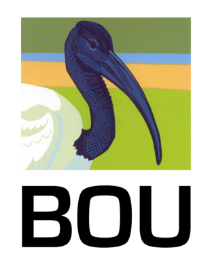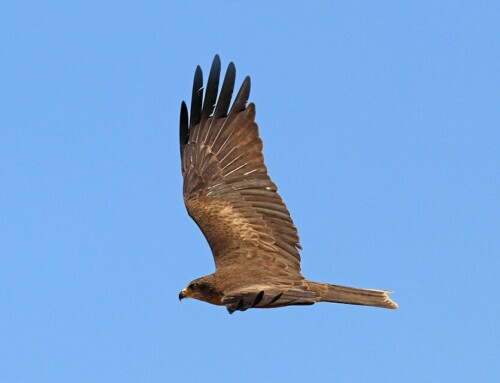
LINKED PAPER
The Use of Drones in Raptor Research. Spaulding, R., Gallego-Garcia, D., Bird, D.M. 2024. Journal of Raptor Research. DOI: 10.3356/jrr2427 VIEW
Climbing a giant tree with a harness and a helmet is one way to check on an eagle nest, but there are other ways. Drones offer an efficient, safe, and hands-off option for surveying raptor nests, and are growing in popularity. In a recent literature review, the authors make a compelling case for drone usage in nest studies for various raptor species.
Wildlife researchers have been using drones for over two decades, but recent technological advances have expanded the utility of drones particularly as a tool for mapping and assessing habitat, as well as studying the distributions and density of various animal groups including ungulates, primates, marsupials, bats, marine mammals, reptiles, and birds.

Figure 1. Steller’s Sea Eagles (Haliaeetus pelagicus) were the first raptor species featured in a published drone study – Russia, 2013 © V. Masterov.
Rick Spaulding and co-authors reviewed 20 papers published since 2003 that addressed the interactions between drones and raptors, with the aim of determining whether drones disturb raptors, how, and under what circumstances. The publications reviewed mentioned a total of thirty-one raptor species with Bald Eagles (Haliaeetus leucocephalus) and Osprey (Pandion haliaetus) accounting for the bulk of North American focal species within the studies reviewed. The first published study using drones to monitor a breeding raptor was done in 2013 to monitor Steller’s Sea Eagle (Haliaeetus pelagicus) nests in Russia.
The authors found that generally, drones had a minimal impact on the raptor species featured in the reviewed publications. To date, drones have been used primarily to monitor nests, meaning that raptor parents are in a heightened state of defensiveness during that time. Even so, few raptors attacked the drones. In some cases, the adults left the nest or circled while the drone was near, but they returned shortly thereafter. Ospreys demonstrated more variable responses than other species. One adult Osprey attacked a drone and destroyed it. Researchers who approached raptor nests by foot and then either observed the nest from the ground or climbed into the nest to check on the nestlings often elicited stronger antagonistic reactions from raptor parents than drones did. Using drones is more time efficient than sending a biologist into the nest, and it’s also safer than traditional methods of using either a crewed aircraft or climbing.

Figure 2. Rick Spaulding driving a drone during a preliminary recon flight – Alaska, 2022 © J. Helm.
Drone usage in wildlife research has endured moments of contention, but the authors state that this letter “provides information and guidance to allow raptor biologists to use drones in a professional and ethical way.” However, they acknowledge that no two situations are alike. “The use of drones should be subject to the analysis of their potential negative effects on raptor populations,” they say. “Individuals may react differently, and one must be prepared to withdraw the drone if there are adverse reactions from the target species.”
There is a lack of sufficiently detailed information on how drones affect raptors because current research focuses on relatively few species and rarely includes necessary notes such as the distance between the drone and the nest, or ability to systematically test disturbances. The authors hope that future drone users will offer more detail in their publications to help create a stronger baseline of information to inform guidelines on drone usage. They also intend to conduct a more comprehensive review on drone usage in raptor research, including investigations into whether drone specs are related to raptor responses, such as number of motors, color, and noise level. They also suggest studies on how drone activity changes depending on the location of the nest in question, for example whether it’s located on an isolated power pole versus a cliff.

Figure 3. A drone-captured photo of a Peregrine Falcon (Falco peregrinus) parent with nestlings © G. Tremblay.
Raptors are top predators which means they serve as bioindicators. When raptors are ill, that means there is trouble elsewhere in the food web. They are also long-lived birds with slow reproductive rates, and they exhibit high levels of parental investment in their young. Because of these traits, breeding studies are important, not only for understanding raptor population dynamics, but also because the reproductive output of a species correlates directly to their conservation status and the health of the ecosystem. Drones can provide safer, cheaper, less-intrusive methods for conducting nest studies that have the potential to aid our understanding of raptor ecology but they must be used with care. For this reason, the authors advocate for more holistic studies on how drones can optimize raptor research across scales and species.
“The bottom line is that these machines can make life easier not only for the biologists but also the birds themselves, if we learn how to use them responsibly.”
Image credits
Top right: Chaco Eagle (Buteogallus coronatus) nestling with drone in the background – Argentina, 2020 © D. Gallego-Garcia.
Blog posts express the views of the individual author(s) and not those of the BOU.
If you want to write about your research in #theBOUblog, then please see here





